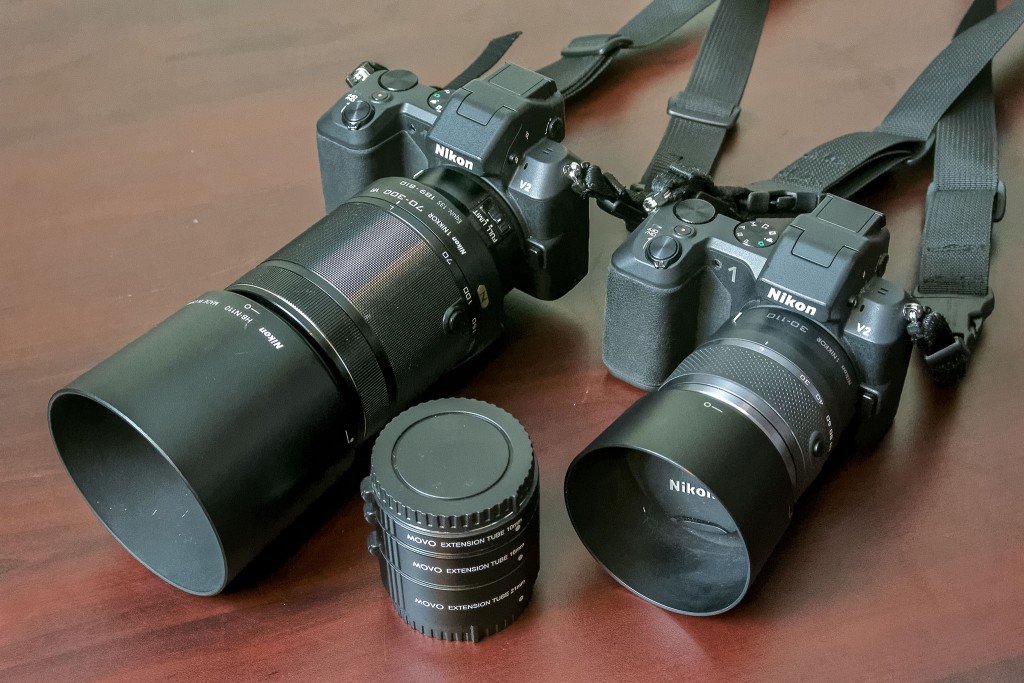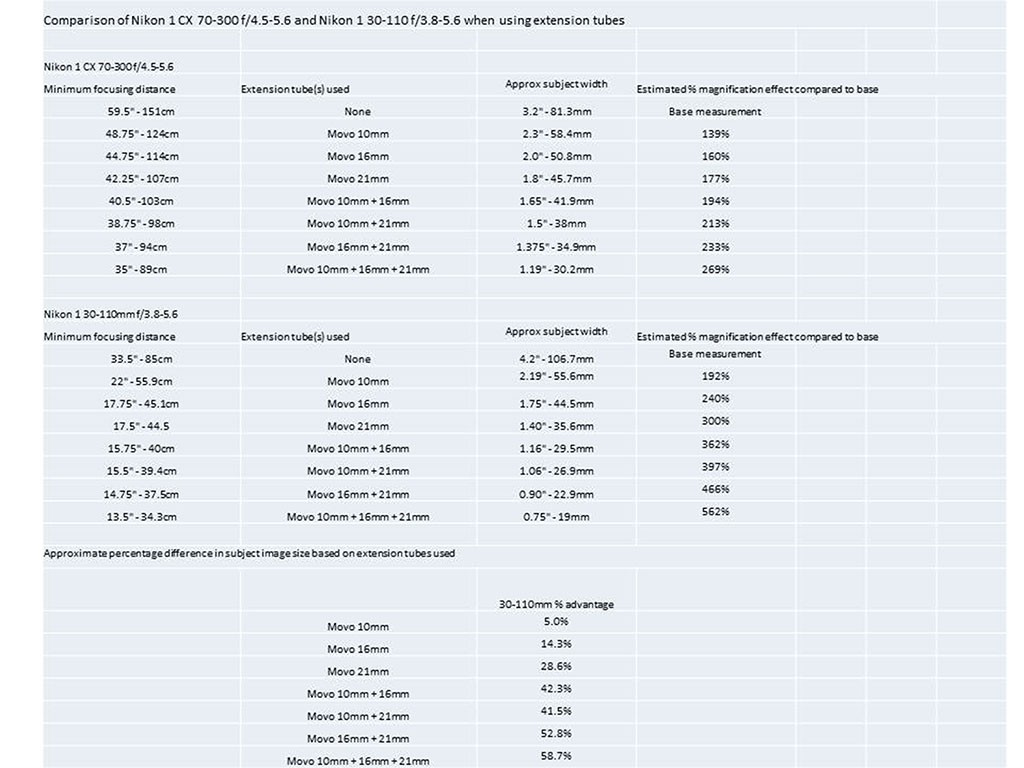Since, at the present time, there are no native Nikon 1 macro lenses available, many owners of Nikon 1 gear use extension tubes instead. For many folks their decision comes down to using extension tubes with either the Nikon 1 30-110 mm f/3.8-5.6 or the Nikon 1 CX 70-300 f/4.5-5.6 lenses.
I recently purchased a set of Movo Extension Tubes for Nikon 1 and I thought it may be interesting to compare the ‘magnification effect’ of the various Movo Extension Tubes with these two lenses when mounted on my Nikon 1 V2’s. The basic question is, “When using Movo Extension Tubes with Nikon 1, which set up works best?”
NOTE: Click on images to enlarge.
I set up a rather crude experiment to try to measure the minimum focusing distance of these two zoom lenses when using various combinations of the Movo Extension Tubes. To assess the relative macro ability of each set-up I then took images of a tape measure, then approximated the width of the resulting subject image.
Please remember that my measurements are only rough approximations and my testing certainly was not conducted under laboratory conditions! Never-the-less the results are instructive and many be helpful for Nikon 1 owners to decide when to use extension tubes with these two lenses.
In terms of the ‘minimum focusing distance’ I measured the distance between the subject tape measure and the flange on the body of my V2. I put together a small chart of my findings which you will find below. Please note that many of the figures in the chart were subject to rounding up/down and they are only intended as approximations.
The Nikon 1 30-110 mm f/3.8-5.6 provided more ‘magnification effect’ than did the Nikon 1 CX 70-300 mm f/4.5-5.6.
I was able to get the lens to auto-focus on the tape measure with all 3 Movo Extension Tubes attached (i.e. 10 mm, 16 mm, 21 mm) at a minimum focusing distance of only 13.5 inches (34.3 cm).
The resulting image of the subject tape measure was 0.75 inches (19 mm) in width. I compared this to the width of the subject image when the Nikon 1 30-110 mm f/3.8-5.6 was shot at its minimum focusing distance when fully extended to its longest focal length, and without any extension tubes (33.5 inches, 85 cm). The resulting image without extension tubes was about 4.2 inches (106.7 mm) in width, for a ‘magnification effect’ of approximately 562% when using all of the Movo extension tubes combined.
The Nikon 1 CX 70-300 mm f/4.5-5.6 operated completely differently than its 30-110 mm cousin.
First, the minimum auto-focusing distance of the lens when fully extended and without the use of extension tubes was 59.5″ (151 cm). With all three Movo Extension Tubes attached the minimum auto-focusing distance was 35″ (89 cm).
In terms of the resulting subject images, the fully extended lens without extension tubes produced a subject image 3.2 inches (81.3 mm) in width. With all three Movo Extension Tubes attached the resulting image was 1.19″ (30.2 mm) for a ‘magnification effect’ of 269%.
These two Nikon 1 zoom lenses work within different camera-to-subject minimum focusing distances. The 30-110 mm f/3.8-5.6 was able to auto-focus between 22 inches (85 cm) and 13.5 inches (34.5 cm) depending on which extension tube, or combination of tubes was used. The Nikon 1 CX 70-300 f/4.5-5.6 was able to auto-focus at between 35 to 48.75 inches (89 cm to 124 cm).
This is actually good news for owners of Nikon 1 gear if they happen to have both of these lenses. They can use extension tubes to get additional ‘magnification effect’ if there is a subject-to-camera distance of between 13.5 to 48.75 inches (34.2 cm to 124 cm). Of course they will need to choose the correct combination of lens and extension tube(s).
My hands-on review of the Movo Extension Tubes for Nikon 1 gear will be available soon for any readers who are interested in this style of photography.
If you enjoyed this article and would like to learn more about the Nikon 1 system, you may want to have a look at our eBook, The Little Camera That Could. It illustrates the capability of the Nikon 1 system through hundreds of original photographs. There is also commentary and tips about the Nikon 1 system. The cost is $9.99 Canadian.
My intent is to keep this photography blog advertising free. If you enjoyed this article and/or my website and would like to make a modest $10 donation through PayPal to support my work it would be most appreciated. You can use the Donate button below. Larger donations can be made to tom@tomstirr.com through PayPal.
Article Copyright Thomas Stirr. All rights reserved. No use, duplication of any kind, or adaptation is allowed without written consent.





Hi Tom, how do these tubes work with the Nikon 1 ?
have they got the 12 contacts to work between the camera
and the lens or do you lose the AF,
regards,Vincent
Hi Vincent,
The extension tubes that I owned were designed specifically for Nikon 1 equipment. Full auto-focus and exposure control was maintained through electrical connections on the tubes that connected the body and lens. When extension tubes are used there are a couple of trade-offs regardless of the camera gear used. The first is that auto-focus is limited and the lens will no longer be able to focus to infinity. The other trade-off is a loss of light. The longer the extension tube (or combination of tubes) used, more light will be lost.
Tom
I bought a Movo set as well. While the lens slides perfectly inside the rings, I have difficulty mounting the rings on the camera. I get a warning on the screen that the lens is missing. If I go any tighter, I feel like the rig is going to gem the camera opening. Is this normal? Is your ring “clicking” in place easily with the camera body?
Hi Dana,
The MOVO tubes do fit quite snuggly on the CX lens mount. It does start to feel a bit tight, but I keep turning gently and I do get a discernible ‘click’ when the tube locks in place.
Tom
hi Guys,
one question are the extension tubes also good to increase the
zoom?? in case not is there a doubler focal for the nikon 1??
Hi Sergio,
When you use extension tubes you will lose focusing at infinity. As far as I am aware there are no teleconverters for native Nikon 1 lenses. You could certain use an FT-1 adaptor with F-mount lenses and a Nikon teleconverter.
Tom
Hi Tom,
Just wanted to ask if you’d ever used these tubes on a V1. Just purchased a set and when they arrived I couldn’t get them to focus any of the lenses I used – I also tried different combos of the tubes. Lastly, I tried them on my second body. No luck.
Unless I’m missing something – must be a manufacturing error. I’ll send them back and request a replacement.
Loving the blog. So much great info here!
Cheers,
Chris
Hi Chris,
I’ve never used mine with a V1 so unfortunately I don’t have any first hand experience that I can share. Sounds like a quality issue with the tubes since they won’t work with either of your bodies. I’m glad you’re finding the blog helpful!
Tom
Hi Tom!
I really love your pictures, even more because you are one of the few nikon 1 users.
I have one question about these tubes. It looks like they have some sort of fiber on the inside to block reflections. I already tested some “film” like this for diy projects and noticed almost all you can buy produce dust like hell. How is it with this tubes? Do you think using them will result in dust on the sensor?
Hi Max,
Thanks for your positive comment – very much appreciated!
I haven’t had any issues with the tubes yet in terms of dust. Since I use eyelead gel sticks to clean my camera sensors dust really has become a non-issue for me anyway. It only takes 10-15 seconds or so to clean the sensor on one of my V2’s so I clean them before each and every use, and if needed I’ll clean them during the shooting of client videos. That’s one of the beauties of a mirror-less camera.
Tom
I have a Nikon 1 Camera because I was so impressed with the images you are getting with yours. Can you briefly explain which of the two lens {choosing between the 10-100mm or the 30-110mm} you prefer and why? This will be my next purchase.
Thanks
Hi Gordon,
I’m assuming that your Nikon 1 camera came with a 10-30mm kit lens so you don’t need the wide angle portion of the 10-100mm focal range.
I haven’t shot with the 10-100 non-PD zoom but I do have the 10-100 PD zoom as well as the 30-110mm. Of the three lenses the 10-100mm non-PD zoom is rated as the least sharp by DxOMark, scoring 3 out of 10, the 10-100mm PD zoom scores 4 out of 10 and the 30-110mm scores 5.
If I had to choose from the two lenses you noted in your comment I’d go for the 30-110 hands down. Based on DxO testing the 30-110 is a much better lens optically. It is sharper, has less distortion and less chromatic aberrations. It does have a bit more vignetting. If you use OpticsPro 10 distortion, chromatic aberration and vignetting will be fixed automatically when you open a RAW file. The 30-110 is smaller, lighter and less expensive as well. If you have any interest in macro type photography the 30-110 is simply a killer lens to match up with extension tubes on a Nikon 1 body. It is so light and easy to handle it makes shooting hand-held with extension tubes a breeze.
I think the only reason that Nikon even made another 10-100 is that the PD version is expensive and hasn’t sold that well. I actually use my 10-100 PD zoom a lot for client video work and I love it. When travelling I do usually take the 10-30 and 30-110 as the pair of them are smaller and lighter combined than is the 10-100 PD.
Tom
These extension tube photos are really very nice. I have used my set of inexpensive extension tubes or a tripod mounted bellows extension a lot over the years. I have found that in many cases I cannot hand-hold the camera because of the great loss of light when using long extensions. Many extension tube photos cry out for applying focus-stacking techniques to in order to achieve nearly infinite depth of field. The problem with this is that if anything in the image moves during the sequencing of the photos the final result will not be any good. Small critters tend not to cooperate by holding still for very long!
I’m glad you liked the photos Mike – and thanks for the kind words! I certainly agree with your points about the potential difficulty trying to hand-hold a camera that has stacked extension tubes – it can be a challenge. The small size and lightweight of the Nikon 1 system really helps when shooting hand-held with extension tubes.
Tom